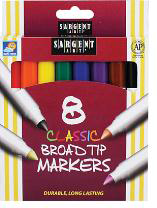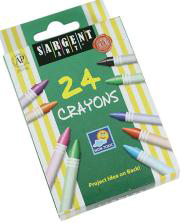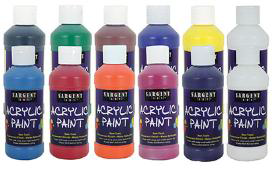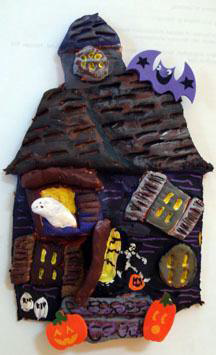Architecture is the study of planning buildings. Architects use structures from the past to design the buildings of today. Students will study buildings of the past to design and create an architectural model of a “spooky house” using Sargent Terra Cotta Air Hardening Clay.
Goal (Terminal Objective):
Students will define Architecture as the study of designing and planning buildings. Students will study buildings of the past to design and create an architectural model of a “Haunted House” using Sargent Terra Cotta Air Hardening Clay.
Objective:
Students will become aware of colors, textures, patterns, and other qualities of architectural building materials. Students will become aware of exterior shapes, patterns, and their arrangement in architectural facades. Students will become aware of historically important architectural design styles. Students will create a façade of a “Haunted House” using Sargent Terra Cotta Air Hardening Clay.
National Standards:
Visual Arts Grades 5-8 Content Standard 1: Understanding and applying media, techniques, and processes
Visual Arts Grades 5-8 Content Standard 3: Choosing and evaluating a range of subject matter, symbols, and ideas
Visual Arts Grades 5-8 Content Standard 5: Reflecting upon and assessing the characteristics and merits of their work and the work of others(Mathematics Cross Curriculum Connection)
Purpose:
Students will become aware of variations of media, techniques, and processes used to investigate Architectural styles. Students will investigate the geometric forms used in Architectural design. Students will compare the way building materials have changed through time. Students will understand that architects create drawings of houses called illustrations.
New Vocabulary:
actual texture, Victorian, pattern, architect, architecture, symmetry, façade, elevation, gingerbread, relief sculpture, geometric shapes and forms, illustrations
Materials:

#22-1530 Classic Broad Tip Markers

#55-0924 Standard Size Economy Crayons Peggable Box

#22-2399 Acrylic Paint

#22-8808 Acrylic Gloss & Varnish

#22-8815 Acrylic Matte Medium
heavy white paper
Time:
This lesson may be modified from one to five hours, depending upon the size and complexity of expectations.
Introduction and Motivation (Set):
View a variety of examples of residential architecture. Discuss with students how different societies around the world and throughout history have developed a specific style of architecture, focus on Victorian style. Discuss the use of illustrations in architectural design. Have students view design qualities such as asymmetrical design, symmetrical design. Observe a variety of roof lines, windows, and other architectural details. Discuss the variety of colors, textures, and patterns created with building materials such as stone, brick, wood, and slate. Discuss how repetition of certain elements gives the façade of a building rhythm. Provide examples of how that rhythm can be disrupted as a house ages or falls into disrepair.
Introduce the model and brainstorm details that could enhance the design and give character to a “spooky or haunted house.”
Instruction:
Teacher will demonstrate the rendering of shapes and textures in the compositional sketch of a “haunted house.” Teacher will demonstrate translating sketch into a clay relief sculpture with architectural elements and a variety of textures. Teacher will demonstrate adding details to enhance the design concept of a “haunted house.” Teacher will demonstrate painting the dried clay relief sculpture.
Activities:
(1)Guided Practice:
- Students generate several sketches of the facades of “hauntedhouses.”
- Students will select one sketch to be constructed in a relief sculpture of a “haunted house.” Student will cut out the sketch along the houseoutline.

- Students will roll a slab of clay, place on a wooden board or piece of matt or card board, and lay the drawing of their house cutting around the outline of the sketch into the clay.

- Students apply shapes of clay onto the surface of the clay house, buildingup areas for interest. Windows, doors, turrets, roof sections, and other architectural elements can beadded.
- After adding all elements, students should refine the shapes and adddetails.
- Students use clay tools to add texture to certain areas and smooth otherareas.
- Students continue to add details to enhance their concept of a “Haunted House.” Allow the relief sculpture to dry. Paint house starting from larger areas to smaller areas. Dry brush may be applied to enhance textural qualities after base coat hasdried.
- Sargent Liquid Metal Markers can be used to add details after paint hasdried.
- Students will compose a narrative writing component inspired by the “Haunted House” portrayed in their reliefsculpture





(2)Independent Practice and Check for Understanding: Teacher circulates among working students visually recording students demonstrating understanding of objectives and providesreinforcement.
(3)Closure:For the mathematic connection, view architectural plans and discussscale used in the illustrations. Have students measure architectural elements and materials found within the school. Calculate an amount of a material to fill a certainarea.
Evaluation:
Level One- The finished Architectural Relief Sculpture very successfully demonstrates the student’s understanding of Architecture as an art form, relief sculpture, architectural shape and form, and architectural elements. Texture is very successfully implied in the design. The house design very successfully gives the impression of an old house fallen to disrepair. The house has several examples of details generally found in illustrations of “Haunted Houses.” The student has shown a high level of craftsmanship and technical skill. The student successfully completed the writing component describing, in depth, a story generated by the “Haunted House.”
Level Two- The finished Architectural Relief Sculpture successfully demonstrates the student’s understanding of Architecture as an art form, relief sculpture, architectural shape and form, and architectural elements. Texture is successfully implied in the design. The house design successfully gives the impression of an old house fallen todisrepair.
The house has at least two examples of details generally found in illustrations of “Haunted Houses.” The student has shown good craftsmanship and technical skill. The student completed the writing component describing, in depth, a story generated by the “Haunted House.”
Level Three- The finished Architectural Relief Sculpture somewhat demonstrates the student’s understanding of Architecture as an art form, relief sculpture, architectural shape and form, and architectural elements. Texture is implied in the design. The house design gives some impression of an old house fallen to disrepair. The house has at least one example of details generally found in illustrations of “Haunted Houses.” The student has shown adequate craftsmanship and technical skill. The student completed the writing component describing a story generated by the “Haunted House.”
Level Four- The finished Architectural Relief Sculpture demonstrates minutely the student’s understanding of Architecture as an art form, relief sculpture, architectural shape and form, and architectural elements. Texture is implied in the design. The house design gives some impression of an old house fallen to disrepair. The house has no example of details generally found in illustrations of “Haunted Houses.” The student has not shown adequate craftsmanship and technical skill. The student has not completed the writing component describing a story generated by the “Haunted House.”
Tips:
Keeping hands moist while constructing the façade of the house will limit the amount of cracks in the clay and facilitate clay building.
Notes:
Suggest students sketch some of the more interesting older homes in their neighborhoods. Discuss the distinctive features students have observed and compare similarities with teacherprovided examples.
Extension:
Surface may have threedimensional objects glued onto the surface to enhance the visual interest.
Resources:
http://en.wikipedia.org/wiki/Architecture/
http://www.architectmagazine.com/
http://architecture.about.com/
http://www.hauntedhouses.com/
http://en.wikipedia.org/wiki/Haunted_house
Art Consultant



